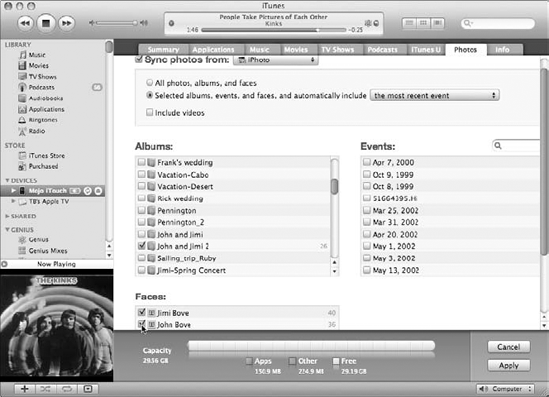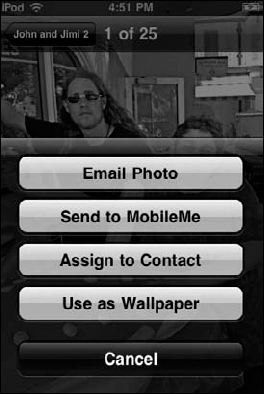Synchronizing photo albums
Viewing photos and slide shows
Taking pictures and shooting videos with an iPhone
Shooting videos with an iPod nano
Sharing your photos and video clips
The world is awash in pictures, from photos and video clips to cartoon images, graphics, and famous paintings. In this chapter, I refer to everything you can see as a picture — whether it be a photo, graphic image, shot of a computer or iPod touch or iPhone screen, or a recorded video clip (a moving picture).
If you like to carry pictures around with you, you're going to love the iPod or iPhone as a player for viewing pictures. And if you like to send and receive pictures by e-mail, you're going to love the fact that you can use your iPod touch or iPhone to share them with others. This chapter shows you how.
After importing photos from cameras into your computer, and importing image files from other sources, you can organize them into albums or collections. On a Mac, you can use iPhoto (version 4.0.3 or newer) or Aperture. On a Windows PC, you can use Adobe Photoshop Album (version 2.0 or newer) or Adobe Photoshop Elements (version 3.0 or newer).
You can then set up your iPod or iPhone to sync with your entire photo library or with specific albums in your library so that any changes you make to the library or to those albums are copied to the iPod or iPhone. In addition, any pictures you collect from e-mails on your iPod touch or iPhone are synced back to the photo library on your computer.
If you don't have iPhoto or one of the Adobe products, you can store your pictures in their own folder on your hard drive (such as the Pictures folder in your home folder on a Mac or the My Pictures folder in your My Documents folder in Windows). You can then use iTunes to transfer pictures from this folder, treating the folder as a single photo album. If you have subfolders in this folder iTunes copies the subfolder assignments as if they were album assignments.
Note
To find out more about organizing pictures into albums, visit the free tips section of my Web site (www.tonybove.com).
To copy pictures from your computer to your iPod or iPhone using iTunes, follow these steps:
Connect your iPod or iPhone to your computer and then select its name in the Devices section of the iTunes Source pane.
iTunes displays the Summary page (under the Summary tab of the synchronization pages) to the right of the Source pane. (See Chapter 9 for details.)
Click the Photos tab.
The Photos sync options appear, as shown in Figure 18-1 (on a Mac, you'll see iPhoto selected to sync photos from).
Select the Sync Photos From check box and then pick the source of your pictures from the pop-up menu: a photo application, the Pictures (Mac) or My Pictures (PC) folder, or the Choose Folder option.
Pick your application (such as iPhoto on a Mac or Adobe Photoshop Album in Windows) from the pop-up menu to synchronize with its library. If you don't use these applications, pick the Pictures folder on a Mac or the My Pictures folder on a PC, or pick Choose Folder to browse your hard drive or other storage media and select the folder containing pictures. After selecting the folder, click Choose (Mac) or OK (Windows).
If you chose a photo application that organizes pictures by album, collection, events, or faces (such as iPhoto), or if you stored pictures in subfolders in your Pictures or My Pictures folder, select one of the following options below the Sync Photos From check box:
All Photos, Albums, and Faces: Copies all pictures and albums (or collections) from the library or folder selected in Step 3.
Selected Albums, Events, and Faces, and Automatically Include: Select this option to be more specific about which albums, events, and/or faces to sync, and to include recent events automatically — you can choose how many recent events or events from the last month or several months from the pop-up menu, or choose All Events or No Events. (In Figure 18-1, I chose The Most Recent Event.) After selecting this option, you can then make selections in the Albums, Events, and Faces columns.
Events column: If you chose a photo application that organizes pictures by events (such as iPhoto), you can select the check box next to each name (or date, if no name) of an event to synchronize.
Albums column: Lets you choose which photo albums from the library (or subfolders from the folder) selected in Step 3 you want to copy. The idea here is to scroll the list box to see all the albums or collections in your library (or subfolders in your folder) and then select the check box next to each one you want to copy. (In Figure 18-1, you can see that I decided to copy the albums named John and Jimi 2 from my iPhoto library.)
Faces column: If you chose a photo application that organizes pictures by faces (such as iPhoto), you can select the check box next to each face's name. (In Figure 18-1, you can see that I decided to copy all pictures with Jimi Bove's face and John Bove's face from my iPhoto library.)
Click the Apply button to apply changes, and click the Sync button if synchronization hasn't already started automatically.
iTunes copies the photo library or albums you selected to your iPod or iPhone (and deletes all other pictures from the iPod or iPhone except those saved in Saved Images or in Camera Roll).
You can save pictures that you receive via e-mail on your iPod touch or iPhone, photos you record with your iPhone, videos you shoot with your iPhone 3GS, and videos you shoot with your iPod nano in a special photo album — Saved Images (for image captures and e-mailed pictures you save) or Camera Roll (for photos and videos you shoot). (I describe how to save pictures from e-mails later in this chapter.)
To synchronize these saved pictures back to your computer, connect your iPod touch or iPhone to your computer as you normally would to sync it (as described in Step 1 of the previous section).
On a Mac, iPhoto pops up automatically — click the Import All button, or select the pictures you want and click the Import Selected button. After importing the pictures into the iPhoto library, iPhoto asks whether you want to delete the originals from the iPod touch or iPhone. Click Delete Originals to delete the pictures from the iPod touch or iPhone (they're safe in your photo library now) or click Keep Originals to save them — in case you want to e-mail them or upload them to social networks from your iPod touch or iPhone.
On a Windows PC, iTunes can be set up to sync with Adobe Photoshop Album or Photoshop Elements (as I describe in the previous section) and will automatically transfer the pictures (including video clips). If you don't use those applications, follow the instructions that came with your photo application to import the pictures, or use the Microsoft Scanner and Camera Wizard to save the pictures to a folder of your choice.
Tip
To import recorded videos to your computer from an iPod nano, the iPod nano must be enabled for disk use — select the iPod nano in the Device section of the Source pane, click the Summary tab, and select the Enable Disk Use option. In addition to appearing in iTunes, your iPod nano from this point on also appears on your computer as an external hard drive, with the same name you gave it during initial setup. Your recorded videos are stored in the DCIM folder on your iPod nano, and you can simply drag them to your computer. To clear space on your iPod nano after you've copied your recorded videos to your computer, delete them from the DCIM folder.
You might remember the old days when you carried fading, wallet-sized photo prints, or worse, a deck of slides that required a light box or projector to show them to others. You can now dispense with all that because all you need is your iPod or iPhone.
Slide shows are an especially entertaining way of showing pictures because you can include music as well as transitions between them. You can display your slide show on the iPod or iPhone, or on a television by connecting your iPod or iPhone to the TV using the Universal Dock, Component AV Cable, or Composite AV Cable from Apple (available in the Apple Store).
Note
To find out how to connect your iPod or iPhone to televisions, stereos, video monitors, and video equipment, visit this book's companion Web site.
To view pictures on your iPod touch or iPhone, follow these steps:
Tap Photos on the Home screen.
The Photo Albums screen appears, as shown in Figure 18-2 (left side), with a list of photo albums. On an iPod touch, the list includes Saved Photos if you've saved pictures from e-mail messages. On an iPhone, the list includes Camera Roll for saved pictures from e-mails and for new photos shot with the iPhone Camera (and video clips shot with the iPhone 3GS Camera).
Tap a photo album's name (or the arrow to the right of the name), or tap Photo Library to see all pictures.
Thumbnail images appear, as shown in Figure 18-2 (right side). The Photo Library choice displays thumbnails of all the pictures in your iPod touch or iPhone (except the Camera Roll or Saved Images albums). Selecting an album displays thumbnails of only the pictures assigned to that album.
Flick your finger to scroll the thumbnails and tap a thumbnail to select a picture.
You might have several screens of thumbnails. Flick your finger to scroll the thumbnails and tap one to select it and view it.
To view a picture in landscape orientation, rotate the iPod touch or iPhone sideways. The picture automatically changes to fit the new orientation and expands to fit the screen if the picture itself is in landscape orientation.
To zoom into the picture to see more detail, double-tap the area you want to zoom into. Double-tap again to zoom out. You can also zoom into an area by unpinching with two fingers, and zoom out by pinching. To pan around a picture, drag it with your finger.
To move to the next picture in the library, flick horizontally across the picture with your finger. You can flick across to go backward or forward through the album or the entire library.

Figure 18-2. Tap a photo album or the entire photo library (left) and then tap a thumbnail image (right).
Tap the full-screen picture to show or hide the navigation controls, as shown in Figure 18-3. You can see the next or previous pictures in the album or library by tapping the Previous or Next buttons that appear when you tap the picture.
To set up a slide show, follow these steps:
Choose Settings

The Photos Slideshow settings screen appears.
Tap the Play Each Slide For option to set the duration of each slide.
You can select ranges from 2 to 20 seconds.
Tap the Transition option to pick a transition to use between photos in the slide show.
The Wipe Across transition is my favorite, but you can select Cube, Dissolve, Ripple, or Wipe Down. Tap the Photos button to return to the Photos Slideshow settings screen.
Select the other options as appropriate for your slide show:
Repeat: Repeats the slide show.
Shuffle: Shuffles photos in the slide show in a random order.
Tap the Settings button to return to the Settings screen or press the physical Home button to return to the Home screen.
To play a slide show, follow these steps:
Tap Photos on the Home screen, and tap an album on the Photos screen or tap Photo Library.
To start the show, tap the Play/Pause button at the bottom of the thumbnail images. (Refer to Figure 18-2, right side.)
Use the navigation buttons to move back and forth in your slide show.
Tap any picture to see the navigation controls (refer to Figure 18-3) to move to the next or previous picture.
Press the physical Home button to stop the slide show.
The Home button returns you to the Home screen. You can also stop a slide show by tapping the picture.
To view pictures (photos and images, but not video clips) on your iPod nano or iPod classic, follow these steps:
Choose Photos from the main menu.
The Photos menu appears with All Photos and Settings choices at the top, followed by a list of photo albums and/or events in alphabetical order.
Choose All Photos or an album or event name.
The All Photos choice displays thumbnail images of all the pictures in your iPod. Selecting an album or event displays thumbnail images of only the pictures assigned to that album or event.
Scroll the click wheel to highlight the thumbnail you want and then press the Select button to select the picture.
You might have several screens of thumbnails. Scroll the click wheel to scroll through the thumbnails. When you select a thumbnail, your iPod displays the picture.
To view a picture in landscape orientation on an iPod nano, rotate the iPod nano sideways. The picture automatically changes to fit the new orientation and expands to fit the screen if the picture itself is in landscape orientation.
Press the Previous/Rewind button to see the previous picture in the album or library, or the Next/Fast Forward button to see the next picture. Press the Play/Pause button to start a slide show (see the section "Setting up a slide show," later in this chapter). Press Menu to return to the thumbnails, and press Menu again to return to the Photos menu.
To set up a slide show, follow these steps:
Choose Photos

Choose Times per Slide from the Settings menu to set the duration of each slide.
You can select ranges from 2 to 20 seconds. Or, you can select Manual to set the slide show to advance to the next slide when you click the Next/Fast Forward button.
Pick your music by choosing Music from the Settings menu and then choose a playlist.
You can choose any playlist in your iPod for your slide show, including On-The-Go and Now Playing. iPhoto lets you assign an iTunes playlist to an iPhoto album, and that assignment is saved in your iPod. If you copy the playlist to your iPod, it's automatically assigned to the slide show.
Select a transition to use between photos in the slide show by choosing Transitions from the Settings menu.
Wipe Across is my favorite, but you can select Cross Fade, Fade to Black, Zoom Out, or Wipe Center. Choose Random if you want to use a different (and random) transition for each photo change. Choose Off for no transition. After you choose a transition, the Settings menu appears again.
Set the iPod to display the slide show by choosing TV Out from the Settings menu.
You have three choices for TV Out:
On displays the slide show on a television. While the slide show plays on your TV, you can also see the slides as large thumbnails on your iPod, along with the photo number within the album or library, and the Next and Previous icons.
Ask displays a screen requesting that you select TV Off or TV On; you make the choice each time you play a slide show.
Off displays the slide show with full-size images on the iPod.
(Optional) Select other preferences from the Settings menu:
Repeat: Repeats the slide show.
Shuffle Photos: Shuffles photos in the slide show in a random order.
TV Signal: Changes your television signal to PAL for European and other countries that use PAL as their video standard. NTSC (also referred to humorously as "never the same color") is the U.S. standard.
To play a slide show, follow these steps:
Choose Photos from the main menu.
Choose an album in the Photos menu, or All Photos.
To start the show, press the Play/Pause button.
Tip
You can also start a slide show when viewing a single picture by pressing the Select button.
If you previously set TV Out to Ask (as described in the previous section), choose TV On or TV Off for your slide show.
TV On displays the slide show on a television (through the video-out connection). You can also see the slides as large thumbnails on the iPod.
TV Off displays the slide show with full-size images on the iPod.
Use the playback buttons to navigate your slide show.
If you set Time per Slide to Manual, press Next/Fast Forward to move to the next picture and press Previous/Rewind to return to the previous picture.
If you set Time per Slide to a specific duration, use Play/Pause to pause and play the slide show.
Press the Menu button to stop the slide show.
Pressing the Menu button returns you to the Photos menu.
So you think those nifty portable video cameras are so cute? Check out the current model iPod nano: you can shoot high-quality video with sound, and even apply special video effects. You can, of course, watch what you record on your iPod nano, and then transfer the video to your computer to edit and share.
Note
To find out how to shoot photos with an iPhone (and shoot videos with an iPhone 3GS), visit the free tips section of my Web site (www.tonybove.com).
Turn your current model iPod nano around, and you'll find the lens and microphone on the back. It points outward so that you use the display as a viewfinder to see the video you're shooting. Be careful not to block the lens or microphone with your fingers — hold the iPod nano on its edges when recording for best results.
To use iPod nano as a video camera, choose Video Camera from the main menu. The screen turns into a viewfinder, and you can shoot video in landscape or portrait mode by rotating the iPod nano. When you're ready to begin shooting, press the Select button. Press it again to stop recording. While you are recording, a blinking red light appears in the upper right corner of the display, next to the recording time.
Tip
You can apply special effects only before recording — the Pod nano can't add or remove effects after recording, and you can't change video settings while recording. To shoot video with special effects, choose Video Camera from the main menu, and then Press and hold the Select button to display the video effects palette. Scroll the click wheel to highlight the effects, and press the Select button to select the one that's highlighted. The viewfinder screen appears with the selected effect — which is fun for viewing the world through the viewfinder. Press the Select button again to start shooting with the special effect, and press it again to stop recording. When you press the Menu button to leave the Video Camera screen, the special effect changes back to Normal.
Your recording time depends on the how much space you have in your iPod nano, and how long your battery can last. A recorded video can be up to 2GB in size. Once a recorded video takes up 2GB of space, recording stops. To resume recording, press the Select button.
The iPod nano saves your recorded videos in the Camera Roll. To watch what you just recorded, press Menu from the Video Camera viewfinder to show the Camera Roll. Select a video by its date and time, and press the Select button to play it. Your recorded videos can also be played from the Videos menu — choose Videos
To delete a recorded video on your iPod nano, choose Videos
To sync your recorded videos with your computer, see "Syncing saved pictures with iTunes" earlier in this chapter.
What good is it to collect pictures without sharing them with other people? You can share pictures in your iPod touch or iPhone by sending one or more in an e-mail, uploading as many as you want to social networks, and sharing entire photo albums using MobileMe. With an iPhone 3G or 3GS, you can also send pictures using MMS (if supported by your carrier). And with an iPhone 3GS, you can record video clips and share them the same way, using e-mail or MMS. You can also upload video clips to YouTube or your MobileMe gallery.
To send an image in an e-mail, tap Photos on the Home screen, tap a photo album or Photo Library, and choose the image for viewing (refer to Figure 18-2). Then tap the picture to see the navigation controls (refer to Figure 18-3).
Tap the Options button in the lower-left corner of the screen to see the Options menu, as shown in Figure 18-4, and then tap the Email Photo button to e-mail a photo or the Email Video button (not shown) to e-mail a video clip. If you have MMS support with your iPhone carrier, you also see buttons to send the photo or video by MMS.
The New Message screen appears in the Mail app for e-mail or in the Messages app for MMS messages on an iPhone. The photo or video clip is embedded in the message. You can tap in the message field to enter text. Then fill in the To and Subject fields, as described in Chapter 20.
Tip
You can also use the Options menu to assign the photo to a contact in your Contacts list (see Chapter 21 for details) or use the image as the iPod touch or iPhone wallpaper (see Chapter 4). If you've set up a photo gallery on MobileMe to share with others, you can include any picture or video clip in this published gallery so that others can immediately see it. Choose Send to MobileMe in the Options menu, and select the gallery to include the picture or video clip.
To select more than one picture (photo, image, or video clip) to copy and paste into another app or to share by e-mail, tap Photos on the Home screen and tap a photo album or Photo Library (refer to Figure 18-2, left side). Then tap the Options button in the lower-left corner of the thumbnail images (refer to Figure 18-2, right side).
The Select Photos screen appears, showing the same thumbnails. Tap each thumbnail on the Select Photos screen, as shown in Figure 18-5 (left side), to select each image. As you tap each thumbnail, a check mark appears in the thumbnail to indicate that it is part of the selection.
The Share and Copy buttons appear at the bottom as you make a selection. To e-mail the selected pictures, tap the Share button and then tap Email. The Mail app launches and starts a new e-mail message that includes all the selected images (see Chapter 20 for details on sending e-mails).
To copy the pictures to another app or paste them into an existing message, tap the Copy button. You can paste the pictures into any app that accepts pasted pictures — such as a saved e-mail draft message in Mail. Touch and hold to mark an insertion point in the e-mail message (which brings up the keyboard), and the Select/Select All/Paste bubble appears, as shown in Figure 18-5 (right side). Tap Paste to paste the images into the message.
Note
You can also receive pictures from others by e-mail. (See Chapter 20 for details on how to check your e-mail.) A down-arrow button appears within a message that contains an attached picture. Tap the down-arrow button to download the picture to your iPod touch or iPhone.
After the download completes, tap the picture in the e-mail message, and the Save Image and Cancel buttons appear. Tap the Save Image button to save the picture in your iPod touch or iPhone photo library (in the Saved Images album) or tap Cancel to cancel. If the message has more than one picture (such as three), you can tap a button to save them all.
You too can capture shots of the iPod touch or iPhone screen and display them in a book or Web site, just as I have. No matter what application you're running, quickly press and release the Sleep/Wake and physical Home buttons at the same time. The iPod touch or iPhone screen flashes (and if your volume is up, you can hear a shutter click). This indicates that the screen was saved in the Saved Images album on an iPod touch or the Camera Roll album on an iPhone — choose the album in Photos to see the picture. You can take as many screen shots as you like. The next time you sync your iPod touch or iPhone to your computer, your photo application (such as iPhoto) launches to receive these new pictures.




